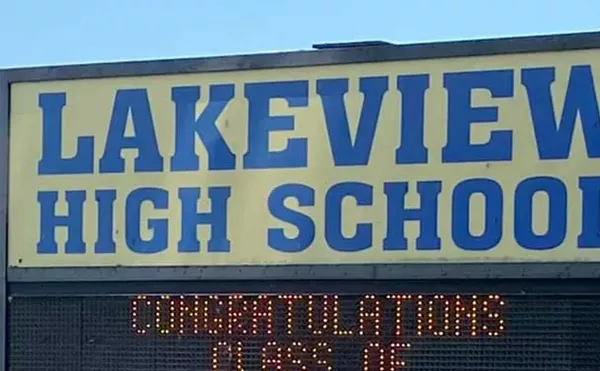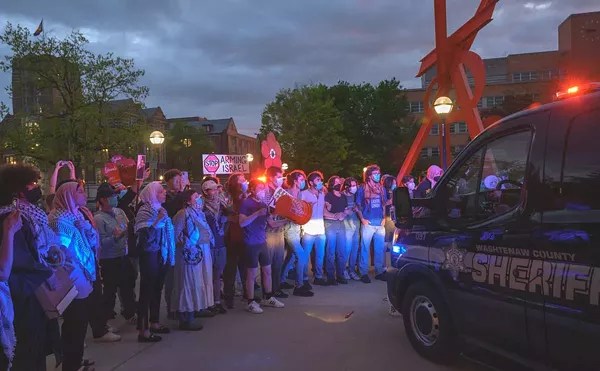
Audio By Carbonatix
[
{
"name": "GPT - Leaderboard - Inline - Content",
"component": "35519556",
"insertPoint": "5th",
"startingPoint": "3",
"requiredCountToDisplay": "3",
"maxInsertions": 100,
"adList": [
{
"adPreset": "LeaderboardInline"
}
]
}
]
Sitting down over lunch at Detroit's Majestic Cafe, Keith Gunter recalls the first time he saw a nuclear power plant. The year was 1966.As a sixth-grader at Taylor's Fairlane Elementary School, Gunter visited the Fermi 1 plant in Monroe as part of a science-class field trip. And he was geeked.
At a time when the space race was in high gear, American schools were doing all they could to instill a love of science in the nation's students. Gunter hands me a commentary, written in 1996 and sheathed in protective plastic, that recounts the experience of visiting the reactor, and his enthusiasm.
"Like so many other kids my age in the mid-'60s, I was bedazzled by science," he wrote. "The Space Age had truly begun and a miracle of a Peaceful Atom seemed somehow, naively connected. All the experts in government and industry told us that nuclear power was the energy source of the future; a virtually limitless potential supply that would be, in the famous words of Atomic Energy Commission Chairman Lewis Strauss, 'too cheap to meter.'"
Within weeks of his class visit, on the eve of Gunter's 11th birthday, the plant experienced a partial meltdown. It wasn't until a decade later that he came to realize how close to catastrophe this region had come. He credits his older brother Paul with the awakening.
Paul Gunter was living in New Hampshire during the mid-1970s, working on prisoner rights for a nonprofit, when he helped found the Clamshell Alliance. The group sprang up in opposition to plans for a nuclear power plant along a salt water estuary in Seabrook, N.H., about 90 miles north of Boston. Nonviolent direct action formed the core of the group's protests, and many, including Paul, were jailed for their activities.
"After Paul was arrested for the second or third time, I asked him what was going on," recalls Keith. "That's when he gave me a copy of John Fuller's book, We Almost Lost Detroit."
Fuller's controversial 1975 account of the partial meltdown — which occurred just weeks after Keith visited the plant on that class field trip — turned him into a steadfast opponent of nuclear power.
Fermi 1 was decommissioned in 1975. Fermi 2, owned by DTE Energy, began operation in 1988. Now the utility is taking the first step toward possibly building a new reactor, to be christened Fermi 3 — if it's ever built. The Gunter brothers are part of an attempt to make sure that doesn't happen.
Now 60, Paul Gunter has been active in the antinuclear movement as an activist and energy policy analyst since his Seabrook days. Keith, 53, is retired from his telecommunications job with AT&T, freeing him to devote himself more fully to the peace, social justice and antinuclear efforts that have been part of his life since the 1970s. (For much of that time, he was also a frequent contributor to this paper.)
Earlier this month, a coalition of nonprofit groups — including the Maryland-based Beyond Nuclear, where Paul Gunter now works — filed 14 legal "contentions" with the Nuclear Regulatory Commission.
The 150-page document raises concerns about Fermi 3's potential "radioactive, toxic, and thermal impacts on Lake Erie's vulnerable western basin, especially considering the cumulative damage already occurring in the Great Lakes due to the presence of 33 operating atomic reactors and dozens of additional coal-fired power plants," according to a press release issued by the coalition.
Included in the same release was a statement from Terry Lodge, a Toledo attorney representing the coalition. "Efficiency and renewable [energy], such as solar and wind, could readily replace the dirty, dangerous, and expensive Fermi 3 proposal," he said. "And they could do so much more cleanly, safely, and affordably."
Also quoted was Michael Keegan, a Monroe resident and member of the group Don't Waste Michigan. "The track record of the Detroit Edison Company is abysmal. The partial core-melt accident at Fermi 1 in October 1966 and the 1993-94 [Christmas] holiday dumping of millions of gallons of radioactively contaminated water into Lake Erie by Fermi 2 speaks to this record," Keegan said.
"The proposed Fermi 3 would represent another half-century of safety and security risks for the Great Lakes shoreline. Many concerned local residents don't want to play yet another round of radioactive Russian roulette."
Edison responded by explaining that its plan is contingent upon an upswing in the state's economy. But if that happens, the utility wants to be ready to meet increased electricity demands in what it considers to be an environmentally friendly way.
"While Detroit Edison has not decided to build a new nuclear plant, we believe that nuclear power will be a vital element in meeting Michigan's long-term environmental, economic and energy goals," replied the utility. "... When the economy recovers, we expect demand for electricity to resume its historical upward trend. And we believe that nuclear power is the best choice for replacing older fossil-fuel plants, especially with the need to reduce carbon dioxide emissions to address climate change."
Selling nuclear power as a way to address the problem of climate change is a tactic being used to help revive a near-moribund industry. According to Paul Gunter, 1973 was the last year an application was submitted that resulted in a plant being constructed and brought online.
Along with environmental concerns and exposure to terrorist attacks, one of the most compelling arguments against construction of new reactors is economic, says Paul Gunter. Historically, completion costs have been triple what was originally expected, putting an often untenable burden on utilities. As a Beyond Nuclear fact sheet points out: "Of the 253 reactor units initially ordered by U.S. electric utilities, 71 units cancelled before construction and 50 units were abandoned during construction, with tens of billions of dollars in sunk costs. ... Cost overruns and construction delays for new construction under way in Finland and France signal that nothing has changed that would significantly alter industry history here in the U.S."
But that dismal record hasn't stopped what's being billed as a "nuclear renaissance." The Nuclear Regulatory Commission is currently reviewing applications for 26 new nuclear reactors.
Because the private sector — even before the current meltdown — has balked at funding construction of nuclear plants, "the nuclear industry has already requested $122 billion in loan guarantees to construct 21 new reactors," according to a February report from the Union of Concerned Scientists.
Currently, the U.S. Department of Energy has just $18.5 billion to finance those loans. "That's just enough to prime the pump," says Paul Gunter. "Which is why the industry's lobbyists on Capitol Hill are, as we speak, pulling out all the stops in an attempt to get hundreds of billions more in taxpayer dollars to go where private investors dare not tread."
The trepidation on the part of the private sector is matched only by the risk to taxpayers since, according to the Congressional Budget Office, the likelihood of default on federal loans made to nuclear reactor developers is estimated to be "well above 50 percent."
"If the lobbyists succeed, and these loans are eventually made," says Paul Gunter, "it will give new meaning to the term 'toxic assets.'"
Curt Guyette is Metro Times news editor. Contact him at 313-202-804 or cguyette@metrotimes.com




